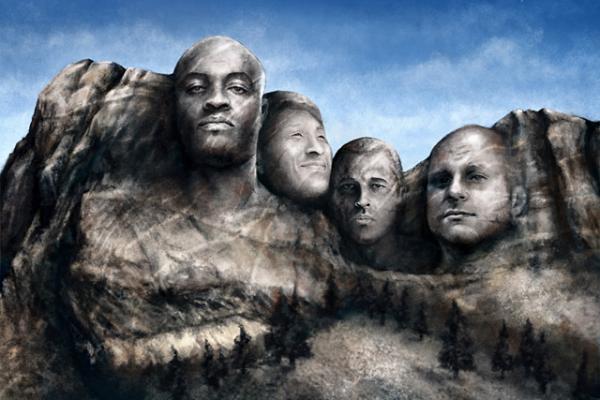MMA’s Mount Rushmore
The First Superstar

Sherdog.com Illustration: Erik Ebeling
Mount Rushmore carries a unique aura of majesty, with the faces of some of America’s greatest political leaders. However, the landmark was originally planned as a more down-to-earth tribute to the Wild West’s most famous figures, and that sort of tradition is more in line with the rough-and-tumble world of mixed martial arts. The question then becomes, who would most deserve to be immortalized on MMA’s Mount Rushmore?
Selecting just four faces for MMA’s Mount Rushmore was not an easy task. There are so many fighters that have distinguished themselves in different ways, and key figures have to be omitted. With that said, this is my best effort to choose a fitting Mount Rushmore for MMA.
Advertisement
With those criteria in mind, here are the selections for MMA’s Mount Rushmore:
Royce Gracie
Nationality: Brazilian
Discipline: Brazilian Jiu-Jitsu
Years Active: 1993-2007
Record: 14-2-3
Dave
Mandel/Sherdog.com
Gracie was the UFC’s first superstar.
For decades, sports fans debated which athletes were the toughest and which martial arts were the most effective. Boxers largely were perceived as the best of the bunch, while the ground game remained a mystery to the general public. That changed at UFC 1 when Gracie used Brazilian jiu-jitsu rather than closed punches to conquer bigger, stronger men.
While Royce was not considered the best fighter of the Gracie family -- that honor at the time went to brother Rickson -- his selection as the Gracie representative for the first UFC tournament made him the family standard bearer to the average fan. His tournament wins at UFC 1, UFC 2 and UFC 4, particularly a dramatic submission of Dan Severn at the close of UFC 4, cemented his status as the biggest star and most intriguing figure in the early UFC.
The Gracies for decades were devoted to the preservation of the family mystique. Royce was no different in this regard, and he carefully protected himself after other fighters started to learn submission defense. He did not duck formidable competition altogether, but he did begin to insist on certain rules and lofty paychecks to return to action. This resulted in making his rare fights feel more important.
In the early 2000s, the focus of the MMA world shifted from America to Japan and Pride Fighting Championships. Perhaps no fighter was more symbolic of this shift than Royce. His legendary fight with Kazushi Sakuraba was probably the most important bout in Pride history, ushering in six years of strong business success.
By 2006, the balance of power in MMA had shifted again. The UFC was thriving on pay-per-view, and Gracie followed the wind once more. A fighter at the center of the early UFC’s success and the heart of Pride’s boom thrust himself into the middle of the UFC’s pay-per-view explosion of 2006.
At the time, Matt Hughes was one of the UFC’s most successful fighters, but he was not a drawing card. A catchweight bout with Gracie was a perfect opportunity to turn Hughes into a star. Hughes-Gracie at UFC 60 drew what was at the time the biggest buy rate in Ultimate Fighting Championship history, and Hughes went on to draw well in future fights with B.J. Penn and Georges St. Pierre.
Upon returning to the UFC, Gracie proclaimed, “I built this house.” He could have been referring to MMA in general. The sport has of course evolved well past the point where a fighter can dominate with one discipline, but it never would have gotten there without Gracie.
Continue Reading » Pride’s Frontman
Related Articles







